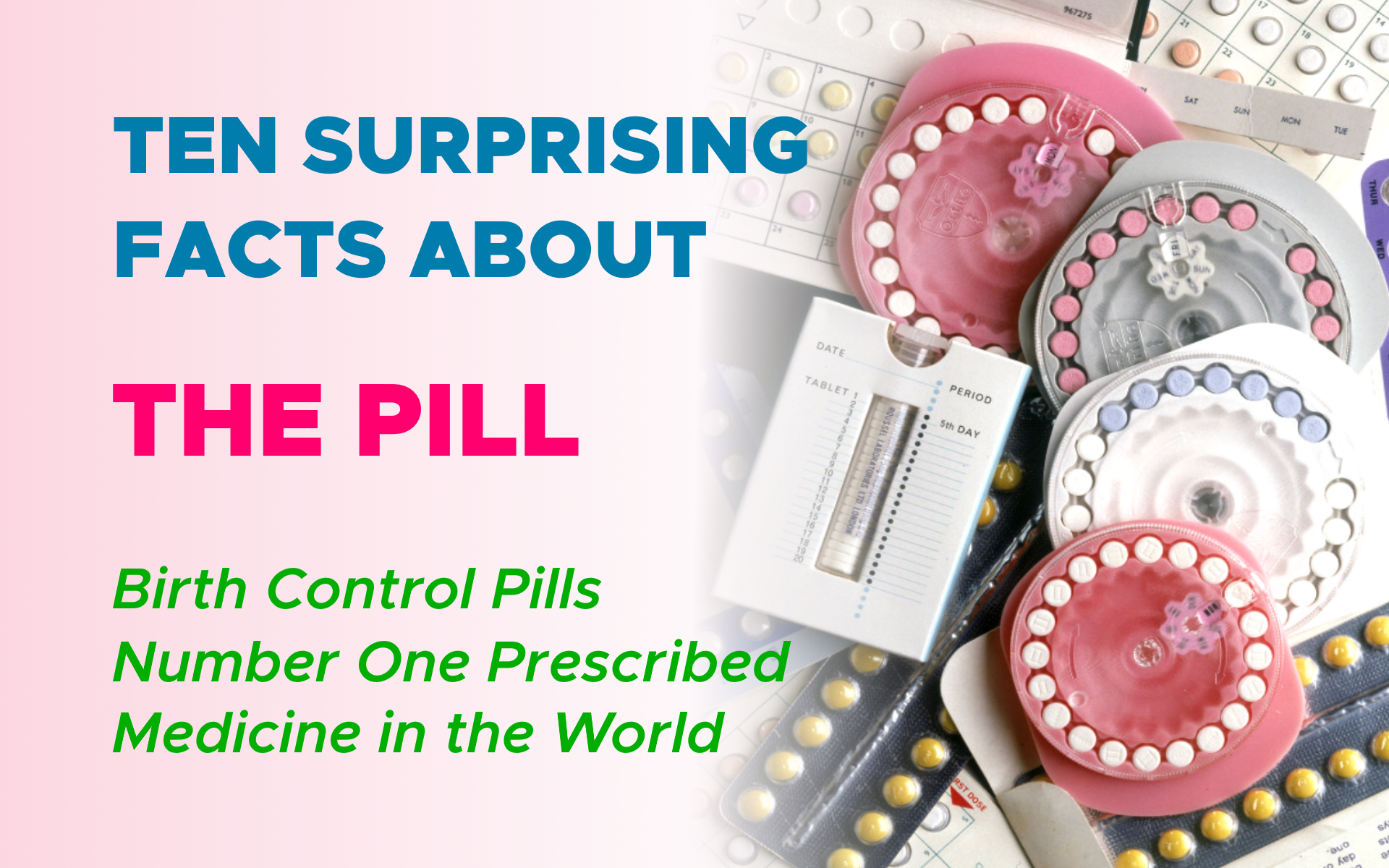
Ten Surprising Facts About the Pill
There is only one drug known so well worldwide, it is simply called the Pill. Birth control pills are the number-one prescribed medicine in the world and, after 50 years on the market, are nearly as familiar as aspirin.
But like any proper lady, the Pill has kept some things close. Here are seven of her most surprising secrets.
1. The Pill Wasn’t the First Oral Contraceptive.
Long before hormonal pills were readily available to women of childbearing age, eating and drinking certain substances served as a rudimentary form of birth control (along with various other fascinating methods).
The residents of Cyrene, a North African city-state in the Greek and Roman Empires, ate a plant called silphion (and harvested it to extinction). Some ancient women ate pomegranate seeds to prevent unwanted pregnancies—inspired by the legend of Persephone—or ingested pennyroyal, which is toxic in higher doses.
Recent research has shown these techniques to be at least somewhat effective, though other ancient methods, like the Chinese practice of drinking mercury, were downright dangerous.
2. The Progesterone Originally Came From a Surprising Source.
Scientists discovered progesterone, the Pill’s main ingredient, in rabbits in 1928. While the researchers immediately realized its potential, progesterone originally could only be extracted from animals — a costly process.
At $80 to $1,000 a gram, the hormone’s primary market in the 1940s was world-class racehorse breeders; they used progesterone shots to improve horse fertility.
In 1943, Russell Marker, a researcher at Penn State, found an alternative source: yams. A wild Mexican yam, known as cabeza de negro, provided large quantities of progesterone precursors, making cheap mass production possible. (Of course, historically speaking, yams are among the tamer of contraceptives people have tried.)
3. The Pill Has a Four-Week Cycle Because of the Catholic Church.
Most birth control pills feature a three-week cycle of active pills followed by one week of placebo pills made of sugar. There’s no biological underpinning that dictates this cycle. Rather, it is the design of John Rock, a devout Catholic doctor who conducted the first human trials of the birth control pill, and biologist Gregory Pincus.
Rock argued that the Pill was a “natural” form of contraception, using hormones that occur naturally in the female body almost like a pharmacological extension of the Catholic-endorsed rhythm method—and thus should be accepted by the Catholic Church.
In an era when birth control was still quite controversial—the Pill wouldn’t be legal for unmarried couples in all states until more than a decade after its 1960 approval by the FDA—the researchers speculated that making it seem like birth control wasn’t interfering with the natural menstrual cycle would make it more palatable to the public.
However, the period that women get during the placebo week isn’t even a real period—it’s a withdrawal response from discontinuing the hormones. It’s perfectly healthy to skip your period by continuing to take the active pills.
4. Loved and Loathed by Feminists
The first drug to be developed for purely social uses, the birth control pill was championed by early feminists. In fact, it was an elderly suffragist, Katherine Dexter McCormick, who footed the bill for its development. McCormick considered the Pill a precondition to women’s freedom.
By the 1970s, however, as the potential health risks of the Pill became public, feminists saw the drug as one more example of an overbearing patriarchy, Gazit explains. They stormed Capitol Hill demanding to know why women should bear all the health risks for birth control. Non-barrier methods of male contraception are still in development.
5. The Pill is Popular, But It’s Not For Everyone.
While the pill is still the most popular reversible form of birth control, the CDC’s data found that use decreases with age: It’s used by 19.5 percent of women in their 20s, 11 percent of women in their 30s, and 5.1 percent of women in their 40s.
An advantage, is that it can be easily stopped if a woman wants to get pregnant. Taking the pill can also ease symptoms of difficult periods, PMS, and acne, says Linda Rice, a certified nurse midwife at Boston Medical Center.
But combination birth control pills, which contain the hormones estrogen and progestin, are not the best choice for every woman.
Not only do these oral contraceptives have to be taken every day, preferably at the same time, but they can also raise the risk for a blood clot, according to the National Blood Clot Alliance. Smokers over 35 and women with a history of blood clots or breast cancer should opt for another contraceptive, the CDC says.
6. May Affect Mating Choice
A growing body of research is suggesting that the Pill may adversely affect mate choice. Normally, the chemicals of attraction pull us toward people whose genes are quite different from our own. Greater genetic variation may enhance a couple’s fertility and make resulting offspring heartier.
The Pill, by inducing a hormonal state that mimics pregnancy, could mess up this process. When a woman is pregnant, she gravitates toward people genetically like herself, theoretically because family members will protect her and her baby during this vulnerable period. But these are not the people she would normally want to mate with!
On the guy’s side, men subconsciously scout for hormonal and physical clues of pregnancy before becoming involved with a gal — after all, the whole point is to impregnate her himself. As a result, men might find ovulating women more attractive than those on the Pill, scientists say. A review of studies on this topic was published in the journal Trends in Ecology and Evolution in 2009.

7. Contains Iron in Placebo Pills
The last week of oral contraceptive pills in a monthly pack does not contain hormones, at least for most varieties of the birth control. The original developers of the Pill included this placebo week to “enable” women to have their monthly period — a decision that was mostly about marketing.
They wanted the Pill to seem as natural as possible in hopes of making it acceptable to women. (It turned out women needed little convincing.)
Today, some manufacturers include iron in the last week’s oral contraceptive pills, in a well-meaning attempt to help menstruating women deal with iron loss. In some women, however, iron supplementation causes gastrointestinal upset, including nausea, abdominal distress, constipation and diarrhea.
So if these issues crop up during the last week of a pill cycle, they may not be caused by your period but the supplement.
8. The First Trials of the Pill in Humans Involved Test Subjects Who Couldn’t Technically Consent.
Starting in 1954, gynecologist John Rock and biologist Gregory Pincus began tests of synthetic oral progesterone, or birth control pills.
While 50 of Rock’s infertility patients volunteered, the drug was also tested on 28 psychiatric patients at Worcester State Hospital in Massachusetts. At the time, anti-obscenity laws in Massachusetts prevented the researchers from putting out a public call for volunteers.
9. Used For More Than Birth Control
Although the original developers always had birth control in mind, the Pill was first approved in 1957 for “severe menstrual problems” — and came with a mandatory “warning” that the drug would prevent pregnancy.
Within two years, half a million women mysteriously developed severe menstrual issues — presumably taking the drug for its “side effect.”
The FDA approved the first version of the Pill for contraceptive use on June 23, 1960. And today, the Pill is primarily used for contraception. However, it can also treat an array of medical issues, from polycystic ovary syndrome and endometriosis to anemia and acne. It is even used to treat bulimia.
Of course, it has also been used to expand women’s role in the work place and spur an international sexual revolution, earning its title as one of the seven wonders of the modern world (The Economist, 1993).
10. The Mini Pill Could Be a Better Choice For Some Women.
Because the mini pill contains only progestin, Rice says, it’s a good choice for women who need to avoid estrogen, such as those who might be at risk for blood clots or are breastfeeding.
Possible side effects include irregular or nonexistent periods, mood changes, nausea, and headaches. But the progestin-only pills are not for women who have breast cancer, advises the American College of Obstetricians and Gynecologists (ACOG).

